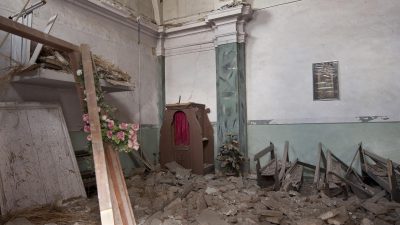Uncovering The Unspoken Truths Behind One Of India’s Deadliest Disasters
The Latur Earthquake, which struck Maharashtra in 1993, is one of the most unexpected and deadly natural disasters in India’s history. Despite the region being considered outside of major seismic zones, the earthquake claimed more than 10,000 lives and left many more injured. What was especially shocking about this event was that the area had no prior history of significant earthquakes, making the disaster even harder to predict.
This devastating event has sparked ongoing studies by seismologists, who believe it was triggered by a previously dormant fault line. Experts agree that earlier monitoring and warning systems could have helped reduce the impact, yet the lack of awareness and preparedness contributed to the disaster’s scale.
The 1993 Latur Earthquake: A Wake-Up Call for India’s Disaster Management
The earthquake in Latur was a powerful reminder of India’s vulnerability to natural disasters, despite being located in a region not considered a high-risk seismic zone. The poor quality of buildings, along with inadequate infrastructure, meant that the effects were much worse than they needed to be. Many homes collapsed, and the region’s emergency response systems were simply unprepared for such a disaster.
The aftermath left entire villages devastated, with hospitals and schools destroyed. The event underscored the urgent need for stricter building regulations and disaster preparedness plans. It also highlighted the necessity of making the public aware of potential risks in their areas.
The True Impact of the 1993 Latur Earthquake: What We Haven’t Been Told
- Government response and missed warnings
Although there were concerns about the possibility of earthquakes in parts of India, the government’s response to these warnings was minimal. There were no significant efforts to improve infrastructure in earthquake-prone areas, and public awareness remained low. This lack of foresight meant that when the earthquake hit, the region was woefully unprepared. - Media’s lack of coverage of seismic risks
Despite the growing scientific understanding of seismic risks, media coverage of these issues was sparse, leaving the public unaware of the dangers. The media’s failure to alert citizens about the risks left many unprepared for the quake, resulting in a higher death toll and greater destruction.
The Hidden Costs of the 1993 Latur Earthquake: Beyond the Ground Shaking
The Latur Earthquake did not only cause immediate physical damage; its long-term economic impacts are still felt today. Billions of rupees were spent on the recovery efforts, yet the destruction of infrastructure, roads, and homes created a profound economic toll. Agricultural production was severely affected, with crops and water sources damaged.
Additionally, the emotional scars left by the earthquake were just as damaging. Many people, especially children, lost their lives or saw their homes destroyed. These psychological effects persist to this day, highlighting the long-lasting toll disasters like these can take on a community’s mental health and wellbeing.
Was the 1993 Latur Earthquake Inevitable? Natural Forces vs. Human Mistakes
- Tectonic activity and human oversight
The earthquake itself was triggered by natural tectonic shifts, but the human element played a significant role in amplifying its effects. The lack of sufficient infrastructure regulations and disaster preparedness meant that even a moderate earthquake led to catastrophic consequences. Had there been more rigorous safety measures in place, the damage could have been mitigated. - Environmental neglect and poor urban planning
Poor urban planning, coupled with environmental negligence, exacerbated the damage caused by the earthquake. Many of the buildings in the area were constructed with little regard for seismic risks, making them more susceptible to collapsing. This oversight in both urban development and environmental management played a crucial role in the scale of the disaster.
What the Government is Hiding About the 1993 Latur Earthquake
- Lack of transparency in the government response
After the earthquake, the government’s response was widely criticised for its lack of transparency. While there was a significant influx of aid from across India and other countries, survivors reported delays in receiving assistance, as well as inefficient distribution of resources. In many areas, help arrived too late to save lives or provide the necessary support. - Post-disaster recovery delays
The government’s failure to implement a coherent recovery plan was evident in the slow pace of rebuilding efforts. While some areas managed to rebuild quickly, others—especially rural areas—suffered from neglect. The lack of a comprehensive long-term recovery strategy worsened the situation and delayed the region’s return to normalcy.
India’s Infrastructure Failings Exposed by the 1993 Latur Earthquake
The earthquake in Latur laid bare the significant weaknesses in India’s infrastructure, particularly in rural areas. Most buildings in the region were poorly constructed and lacked the strength to withstand the powerful tremors. This caused widespread destruction, with homes and public buildings collapsing in minutes.
Furthermore, the country’s disaster management systems were shown to be unprepared for such a large-scale disaster. With limited emergency services, the government was unable to provide immediate relief, exacerbating the suffering of the people affected.
The Aftermath of the 1993 Latur Earthquake: The Devastation That Still Lingers
The immediate aftermath of the Latur Earthquake was a scene of total devastation. Entire villages were flattened, and key infrastructure—roads, bridges, and schools—was destroyed. While search and rescue efforts were quickly mounted, the scale of the destruction meant that many survivors were left without shelter, food, or medical care for days.
The human toll was staggering, but the rebuilding process took years, leaving some areas still grappling with the effects of the earthquake. For many, the earthquake’s impact is still a painful memory, one that serves as a reminder of the need for better preparedness in the face of such natural events.
The Latur Earthquake: Why It Still Matters Today
Though nearly three decades have passed since the Latur Earthquake, its lessons are still relevant. The disaster showed the dangers of underestimating seismic risks in non-traditional earthquake zones and highlighted the flaws in India’s approach to disaster management. While some improvements have been made since then, it is crucial to remember the mistakes of the past and ensure that future disasters are met with better preparedness and response.
Conclusion: The 1993 Latur Earthquake’s Lasting Legacy
The Latur Earthquake was a tragic reminder of the unpredictable nature of earthquakes and the devastating effects they can have on unprepared regions. The event exposed serious flaws in India’s infrastructure, disaster management policies, and response systems. While some progress has been made, the earthquake remains a stark example of what can happen when a country fails to heed early warnings and plan accordingly for seismic risks.
Conclusion: Ensuring the 1993 Latur Earthquake Is Not Forgotten
The Latur Earthquake continues to resonate in the collective memory of India, especially for the communities most affected. The lessons learned from this disaster have shaped India’s current approach to disaster management and infrastructure development, but there is still much work to be done. Remembering the event is crucial to ensuring that future generations are better prepared for such a catastrophe.
5 Short FAQs
- What triggered the 1993 Latur Earthquake?
- The earthquake was caused by tectonic shifts along a previously inactive fault line, which caught the region off guard.
- How many casualties were reported from the Latur Earthquake?
- More than 10,000 people died, and thousands more were injured due to the earthquake.
- Was the Latur Earthquake predicted?
- No, the earthquake was not anticipated, as the region had not been classified as a high-risk seismic zone.
- What were the economic impacts of the Latur Earthquake?
- The economic damage was extensive, with billions spent on rebuilding, while local agriculture and businesses suffered significant losses.
- What measures has India taken to prevent future disasters like the Latur Earthquake?
- India has introduced stricter building codes, enhanced disaster response systems, and greater public education on earthquake preparedness.
References:
“1993 Latur earthquake”
“Latur Earthquake 1993: Causes, Impacts, and Rehabilitation Efforts”




